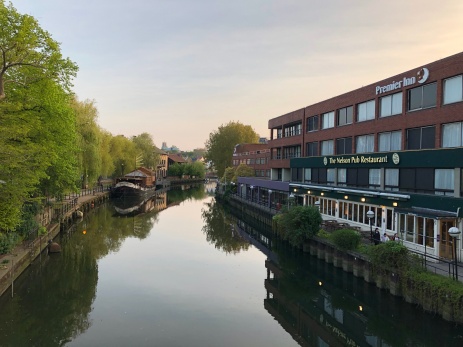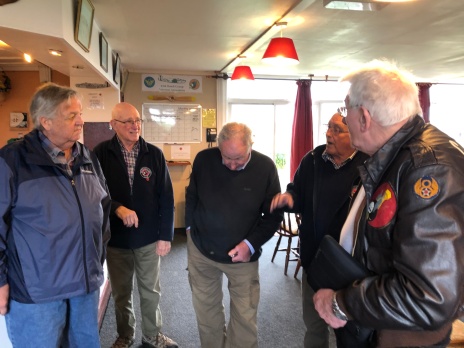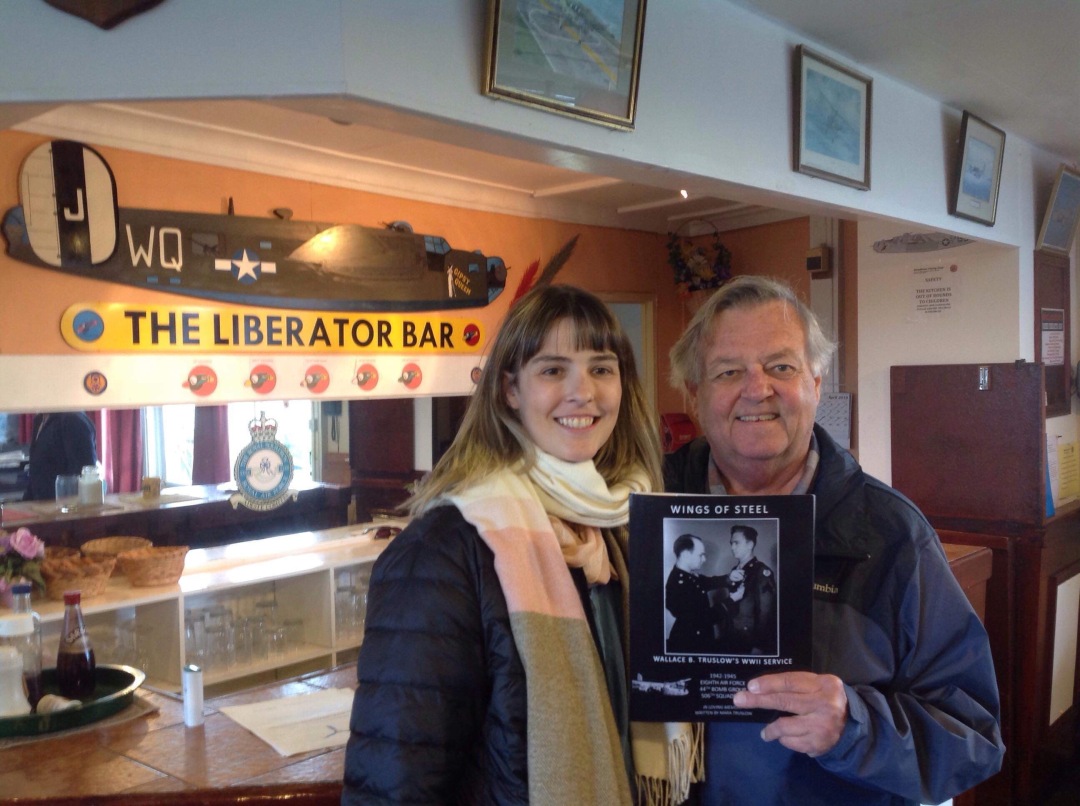With the groundwork laid about the Mighty Eighth Air Force and the 44th Bomb Group, I’m eager to look back to April and the days and moments in Germany and England that are lingering in my mind.
(If you missed the first two posts about the history of the Mighty Eighth and how I met Shipdham, home of the 44th Bomb Group, I’d recommend pausing here and skimming these two posts to get the Cliff Notes.)
Beginning in Berlin and ending in London, it was three and a half weeks of historical bliss. While my trip ended in England, it’s a fitting place to start because it marked the start and end of each of Wally’s 42 missions.
A motley crew of individuals have made it possible to piece together the operational history of my grandfather’s 10 months and 6 days at Shipdham and bring his service back to life, so it feels right to begin the story of our visit to Shipdham with the men who made our visit there possible.
From City to Country
Finding my way to England from the continent (Paris, specifically) was replete with anticipation. I would be gaining a new travel companion on this leg of the trip with my dad making the long trip from Idaho to spend a week with me in his father’s wartime footsteps. Selfishly, I was also looking forward to speaking English after two weeks of communicating in broken French and German.

The pre-dawn EuroStar in Paris, a shlep on the Tube, and a struggle up stairs with a month of luggage gave way to Liverpool Station in London and the much awaited Greater Anglia train line. My eyes looked down from the train platform assignments flickering above, and an unmistakably familiar suitcase came into view. A familiar figure brought instant joy. Glen Truslow, my dad, was 50 feet away, engulfed in a sea of people. Serendipity was in the air, as we’d planned to meet in Norwich since neither of us were using our cell phones internationally. I was grateful for a slice of home as we boarded the train to Norwich.
Arriving in London brought me within 100 miles of Norwich and the heart of East Anglia, which would be our jumping off point for the week. Situated northeast of London, Norwich has viking roots and a long history. The aphorism lovingly recited by locals, “a pub for every day and a church for every Sunday,” may not be reflective of modern Norwich, but it underscores the activities that have defined life in the pastoral East Anglian countryside for centuries.

Norwich would serve as our home base for the week. Situated on the River Wensum across the street from the Train Station that’s changed little since the war, the trees lining the river audibly swayed in the breeze, exuding the peace of the place. Meandering, cobbled roads constructed over many centuries connect a selection of the oldest pubs in England. We were welcomed to Norwich with glorious weather, namely the sun shining, which would prove to be the exception, not the norm for the remainder of the week.
Separated by 30 miles of winding one-lane roads, Norwich is the nearest town of any size to Shipdham Airfield. A sleepy village built on agriculture, Shipdham boasts but a handful of pubs and churches. The airmen lived for the evenings they could hitch a ride on the “Liberty Truck,” from Shipdham to Norwich so they might enjoy a night at the dance hall or pub. Even though Norwich lacked the hustle and bustle of the cities back home, it provided a welcome respite from Shipdham. The airmen happily endured an hour-long drive in blackout conditions jammed in the back of an open-top 2.5 ton truck if it meant a night away from base.
Anticipation of Shipdham
As we sipped scotch after dinner, we relished feeling Wally’s presence at every turn catching ourselves saying, “I wonder if Wally ever came here,” as we walked through cobbled streets. In the morning we’d no longer wonder if Wally had been there. The remnants of the air base at Shipdham Airfield awaited in the morning. For almost a year, Shipdham was the epicenter of Wally’s life. 2,534 called Shipdham homebase during the 10 months from 1944-1945 when Wally flew combat missions. The airmen were the tip of the spear; many times more personnel were needed to keep the base operational in support of the one overarching goal: dropping bombs on strategic targets in enemy-occupied Europe. With thousands of men living on base, Shipdham was a village unto itself during the war. Today, little remains of the base beyond one runway, a concrete slab harboring an untold history.
My dad asked for a refresh on the cast of characters who’d show us to Shipdham. I kept it short and sweet: Barry, the Administrator of Shipdham Flying Club, the gatekeeper to the museum and history of the 44th. John, an ostensible historian of the 44th after decades of meeting and commiserating with the veterans. Mike, whom Barry arranged to pick us up from our hotel; the mystery man who we’d soon learn more about.
When my dad asked how I found Mike, Barry, and John, I found it difficult to explain exactly, as it was the result of many months of internet sleuthing and getting in touch with a maze of contacts. Ultimately, it was Barry and John who agreed to show me Shipdham; their generosity evident before the visit began when Barry arranged transit for us to Shipdham in lieu of a taxi. Because of the sacrifices and ordinary heroism of Wally and his comrades, an innate, deep friendship remains between those who knew and loved the men of the 44th.

Barry gave me fair warning that almost nothing remained at Shipdham Airfield from the wartime years. The shell of the Control Tower and one-third of the runway are the last remnants of the men who fought tyranny to free a foreign people 75 years ago. Yet, it wasn’t the structures that drove my emphatic desire to visit Shipdham. Instead, it was to stand where Wally did, feeling the presence of my grandfather and his crew at the only home they knew during the war, and to share this experience this with my dad, Wally’s son, thereby bringing three generations back to Shipdham Air Base for just a moment.
Nice to Meet You, Shipdham

Waiting in the lobby of our hotel the next morning, I scanned the lobby for a man I’d never met who would take us to Shipdham – Mike. Right on time, I spotted a man sporting a fleece with an emblem of the 44th Bomb Group, a Flying Eight Ball, and felt safe in assuming this was Mike.
Introductions aside, I asked his connection to Shipdham. Without any airs, he told us that he owned the Flying Club. I was taken aback that he would have any interest in chauffeuring us to Shipdham. One moment Mike was a stranger, the next a dear friend, as he and my dad talked all things aviation, and I chimed in about the history of the 44th on our drive from Norwich to Shipdham.

The road to Shipdham was quintessentially English – so narrow only one car could fit on the two-lane road and constant curves despite the flat, pastoral countryside that flanked it. This was the only road to Shipdham during the war.
As we entered the gate that once marked the perimeter of Shipdham Air Base, the runway came into view. The runway bifurcates an operational farm. Industrial farm equipment raked the fields on either side as we drove down the runway towards the flying club. The stench of manure wafted with the wind, an unusual smell to associate with an active airfield. 75 years ago, I’d venture that this same smell was equally off-putting to the airmen arriving here.
A low cloud ceiling hung towards the ground over Shipdham Airbase that welcomed us with a cold rain. While I’d been warned of the unpredictable precipitation in East Anglia, I hadn’t expected the accompanying frigid wind that knocked the air from my lungs like a sucker punch to the gut. It was late April and the temperature hovered in the low 40s. I wondered how Wally survived here in the winter after growing up in Southern California.

We made the quick jaunt from the car to the clubhouse and hangar situated just beyond the runway. The clubhouse is a moving tribute to the 44th Bomb Group. Privately owned, the club has no obligation to honor the Flying 8 Balls, and yet, they pay homage to the group at every turn. Inside the clubhouse, the eye was drawn to mural featuring dozens of B-24s flying through fluffy, cumulus clouds. Group markings were meticulously painted on the fuselage and tail of each bomber that hangs in this landscape amongst the heavens. As the day revealed itself, so too did the many talents of Mike’s arsenal of talents, including painting this focal point of the clubhouse.

Opposite the wall is the “Liberator Bar,” which serves food and drink to those who fly in from neighboring war-era bases that still operate for pleasure flying. Here, Barry, the Administrator of the club who coordinated our visit, was awaiting our arrival. Just as soon, John arrived sporting his original airmen’s A-2 leather jacket with the 44th Bomb Group patch. Facebook friends, John and I spent many months messaging about the history of the 44th because of the unique knowledge built from decades building relationships with the airmen and their families who returned to England after the war.
Moments at Shipdham that Linger
Wally’s presence was palpable throughout the day in a series of moments that brought his service back to life. While visiting Shipdham was a portal to the past, the experience of being there cemented the future with new friendships across the pond forged because of the history made at Shipdham.

Five moments at Shipdham are the next stop: Finding Wally at Shipdham. The gift of flight. Throttling down a runway seeing the past and present blur. Generosity beyond reason and expectation because of a 75-year-old bond.
These seconds and minutes at Shipdham underscore that the past is prologue and that Wally’s actions 75 years ago foster a generosity of spirit today that lingers large in my mind.
Hope to see you here again soon.



My own father, John B Lord, flew in the 506th, one of the 4 squadrons of the Flying 8 Balls. He never made it back to Shipdham after being shot down on his 7th mission on October 7, 1944. Spent the rest of the war at Stalag Luft IV until Feb 7, 1945, when the camp internees began marching away from the Russians on what has been called (not by him) the “death march.” One day I hope to make it to Norwich and then to Shipdham.
LikeLiked by 1 person
Thanks so much for leaving the comment. It’s great to hear from you. I was so grateful to return to Shipdham with my dad (my grandfather Wally’s son). I hope you’ll be able to visit someday – it was remarkably impactful.
Incredible to hear a snippet of your dad’s story. I took a look at his legacy page on the dashboard I built (www.44thbombgroup.org), which includes a 1982 letter he wrote to Will Lundy. I was struck by the following excerpt, and I wonder if you have any context on the “true story?” I’d be curious to know more!
“I am sorry that I lost touch with our pilot, Homer E. Still. Unfortunately, this was on purpose because I did receive an invitation to his wedding a year or so after the war, but at that time, I thought that he had made some bad decisions which led to our being shot down. I did not find out the true story on this until many years later when John Wilson and I were reliving the momentous events of 7 October 1944.”
Best,
Mara
LikeLike